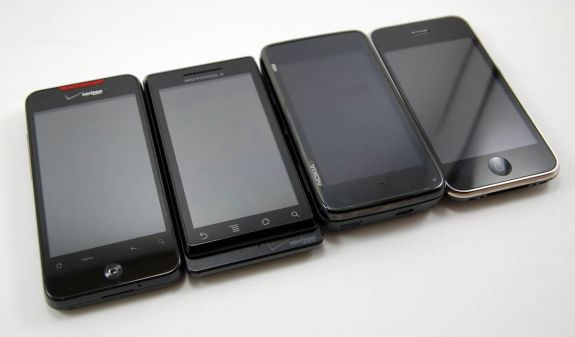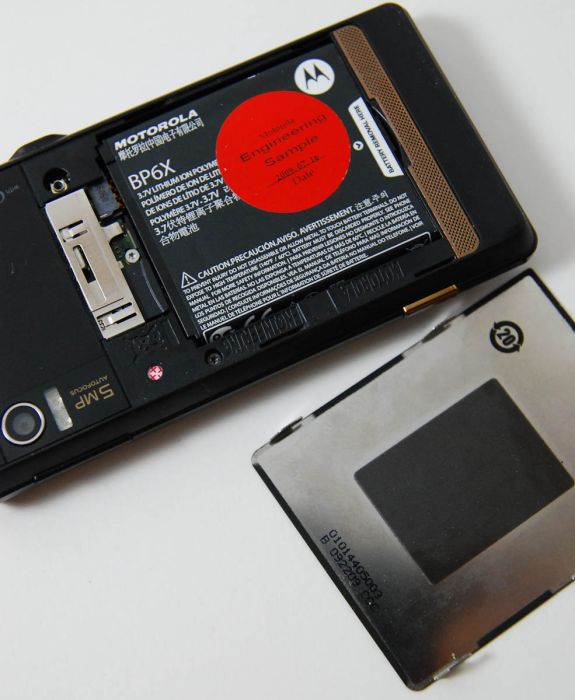Two OMAP 3430 Phones: Nokia N900 and Motorola Droid
by Brian Klug on June 10, 2010 9:29 PM EST- Posted in
- Smartphones
- N900
- Maemo
- Motorola Droid
- Droid
- MeeGo
- Android
- Mobile
It’s impressive Motorola was able to get this right. Previously, only the likes of HTC could get sliding mechanisms to feel just right, yet completely solid. And even then, an occasional slider mechanism would just be errant and misbehave. I remember my HTC Mogul surprising me one day when I slid out the keyboard and it suddenly explosively separated - due to wear on the spring loaded system - sending the display assembly rocketing across a room, ribbon cable flailing behind. I don’t feel like the Motorola Droid would put me through a similar ordeal. It’s solid.
What really set my impression the most though was how snug and firm the battery door feels. Compared to other snap-on plastic battery doors, the Moto Droid’s is perfection. It’s strange how much I’m impressed with it, really, but it’s a surprisingly good microcosm for how good the mechanism is. It’s an honest-to-goodness metal cover that slides and locks onto the back. It doesn’t jiggle when the phone vibrates, and consequently doesn’t make obnoxious noises either. I later learned that all of the Motorola Droid's case is metal, with the exception of a plastic strip where the camera is - for the antennas. Incidentally, right here is also where the phone gets warmest during use.
The only major gripe hardware wise is that the volume rocker on the side feels loose. Searching around online, this seems to be a relatively common complaint, although the volume rocker never missed a button press, it was a bit unnerving. Similarly, the camera button required an impressive amount of force to trigger - usually the only way to know was by feeling for the vibration feedback. In Motorola's defense, this is probably to prevent accidental input in your pocket, but it's a hearty amount of pressure to get that camera app open if you're using the button. Just use the application launcher; really, you'll save scaring yourself.












68 Comments
View All Comments
Affectionate-Bed-980 - Friday, June 11, 2010 - link
You talk about the display brightness and how nice it looks, but you need to mention gamut. In some tests the 3GS shows ~65% of gamut, while the Droid shows 102%. Nexus One is at 141%. I expect the Incredible to be around there, so while the colors look nice on AMOLED, you must remember it's over-saturated and inaccurate while the Droid is spot on at 102%.fabarati - Friday, June 11, 2010 - link
I think you've misunderstood what gamut means.When a screen is advertises as 98% of the Adobe sRGB Gamut, it means that the screen covers 98% of the colours defined by Adobe for that gamut..
If it says 141% of the Adobe sRGB gamut, it means that it covers more than that defined area. It doesn't mean that the colours are oversaturated. It also doesn't mean that it can display all the colours there is.
Read up on gamuts on wikipedia:
http://en.wikipedia.org/wiki/Gamut
Powerlurker - Friday, June 11, 2010 - link
On the other hand, I doubt that anyone is going to do color correction or some sort of display calibration on their smartphone, and since most companies set their displays to be somewhat saturated by default, I would guess that in practice the Incredible's AMOLED screen will be oversaturated compared to the Droid's LCD.Brian Klug - Friday, June 11, 2010 - link
So here's the problem - there's absolutely no way to measure it. Or at least, I haven't found an acceptable solution.Going off the display panel numbers seems extremely unrealistic for obvious reasons, but barring that there are other bigger problems.
1. Android uses 16-bit color in a lot of places because they're rendering them with 3D OpenGL compositing and compressed textures. One of the most glaring - and dare I say troubling - examples is right inside the gallery application. The gallery application in 2.0.1 was full 24-bit color, but in 2.1 Google contracted with Cooliris to develop a more flashy 3D gallery. Obviously, the limitations imposed by the GPU on different devices (and possibly even from the POV of what textures are supported) necessitated 16-bits per color. In practice, it just looks awful. Without even being nitpicky, I can notice lots of banding.
2. The AMOLED displays use the PenTile array, which also does a lot of dithering inherently - in fact, their pattern is essentially trying to get around Nyquist by being very creative with the human eye system, and this intermediate software layer of theirs. The consequence is that it ends up smoothing and dithering the 16-bits, making it really hard to see the banding, but it's still there. Pull up the color gradient images from the article and scrutinize the Incredible. There's no banding, but in person, you can stlll pick out dithering and a problem.
3. I still have no way of doing gamut testing on any mobile devices. So back when I started on the iPad article, I had a (relatively clever, I think) idea to use the calibration software through a 24-bit remote desktop session, tricking it into using any mobile device like a screen. This just doesn't work for reasons outside my understanding. I've done it on iPhone OS and Android, and for some reason the results are just complete bogus. So there's no way of really telling what the % gamut coverage of Adobe 1998 any of these things are. Moreover, since there's no way of loading a display profile on them, you're really stuck with whatever it shipped with anyways.
The sad state of things is that AMOLED "looks" brighter and more contrasty, but the color accuracy is just undoubtedly wrong. I mean, it's obvious to make that comparison when you're surrounded by calibrated IPS panels with Delta-E tracking under 1.0, you hold up any of the phones, and see a veritable library of differently hued photos.
I'm open to any suggestions you guys have for really measuring gamut. I mean, we could try being more manual and laboriously testing colors one by one (that's basically how I do brightness - white, black, and contrast) but, is it worth it?
KevinToon - Friday, June 11, 2010 - link
Shouldn't the speakerphone testing be done with the devices suspended off the desk??I know my phone sounds different if it's on a hard surface like a desk.
R3MF - Friday, June 11, 2010 - link
I have an n900, so thanks, good article.Found an interesting MeeGo article since you mentioned it:
http://jedibeeftrix.wordpress.com/2010/06/06/ultim...
medi01 - Friday, June 11, 2010 - link
May I ask why 3GS is missing from "side by side comparison"? Just an incident or you are THAT afraid of Mr Jobbs marketing's wrath?dtreader - Friday, June 11, 2010 - link
Wow! Just moments after finally placing my order for an N900 about eight hours ago (I've been lusting over this phone ever since it was just rumored to exist), I noticed this article on AT, with no comments having been posted to it yet. Cool, huh?I have a feeling there are many people like me....people that have been thinking about purchasing this incredible phone, but have been holding back for various reasons: for the price to come down a bit, to see how Nokia supported it with software updates, to find out about bugs and if they're being fixed, to feel comfortable about the future of Maemo on the N900 and, at this point, feeling comfortable about buying this phone even if Nokia comes out with something better in a few months time.
I've been depending daily on my flip phone/N800 tablet combination for a few years now, and have been dying to step up to the next level, even before I knew that would come in the form of the N900. A few months ago I looked at the Droid (currently I'm with Verizon), and lately considered the htc EVO on Sprint, but when you combine the current capabilities and the exciting future of the N900 (thanks to its truly open philosophy and dedicated enthusiast/developer base), I just couldn't wait any longer to get on board! T-Mobile 3.5G here I come!
Thanks for this article, Anandtech! You've been my main "source for hardware analysis and news" for over ten years now! :)
Go N900!!!
milli - Friday, June 11, 2010 - link
"From a performance perspective, the Motorola Droid's 550 MHz Cortex A8 simply isn't a match for the 1 GHz A8 in Snapdragon's Scorpion CPU ... "That should read: ... for the 1 GHz Scorpion CPU in the Snapdragon ...
There's no Cortex A8 in the Snapdragon.
Brian Klug - Friday, June 11, 2010 - link
That's being a bit semantic I think.Inside the Snapdragon is a Scorpion, which is Qualcomm's trade name for their hardened (1 GHz supporting) Cortex A8 CPU.
Cortex is the ARM Family, ARMv7-A is the family, and Cortex A8 is the fully qualified core name.
So really, either one is correct ;)
-Brian